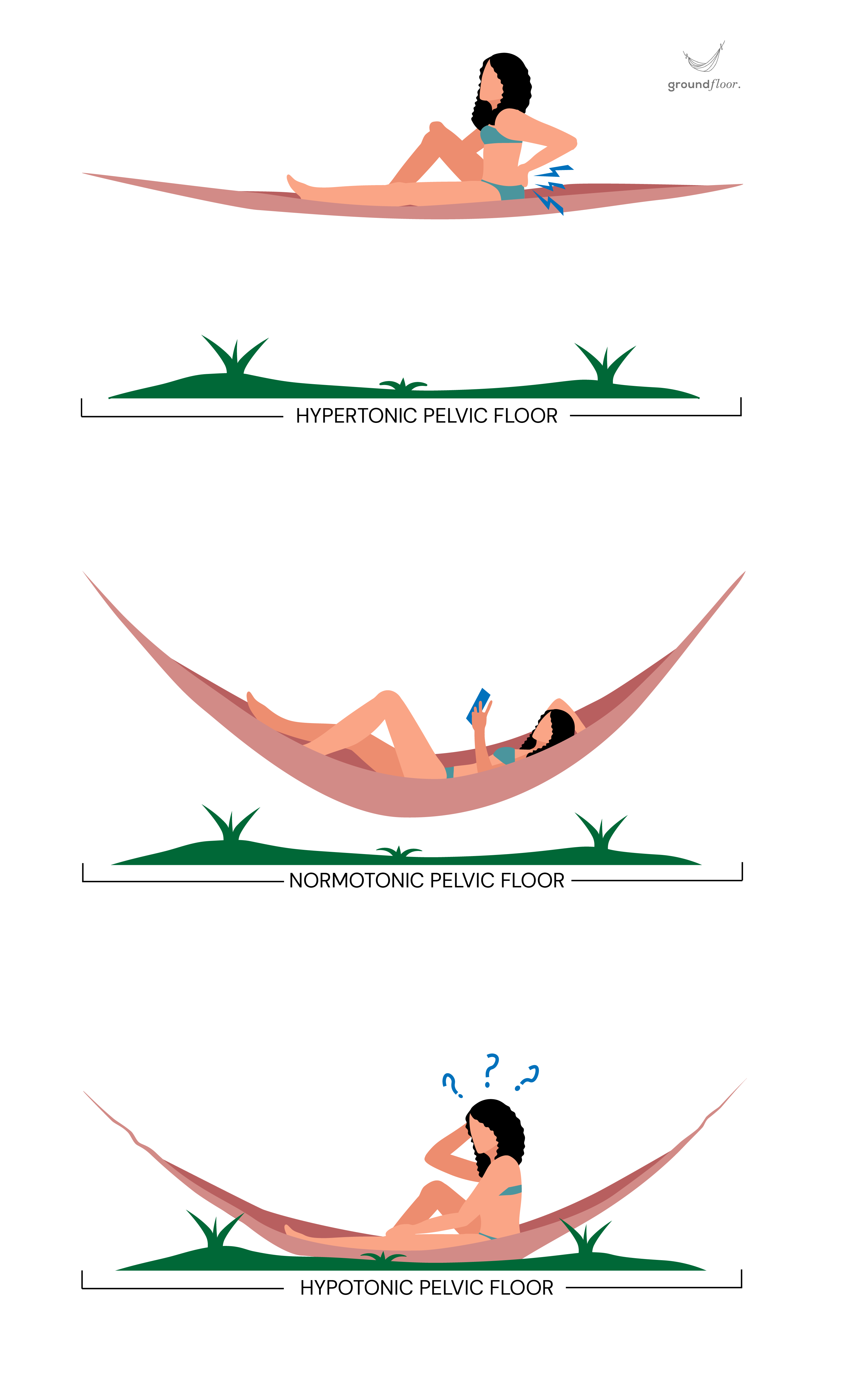
Now that we have explored the anatomy and functions of the pelvic floor, let's reinforce this concept using a simple analogy. By the end of this article, you will have a crystal clear image of the pelvic floor, leaving no room for uncertainty or confusion.
The analogy of the hammock
Imagine your pelvic floor as a hammock attached from the pubic bone (front) to the tailbone (back) and at the sit bones (on both sides). Picture it with a minor defect of three little gaps in the middle.
This analogy will illustrate what we mean by support function, pressure management, and gate control. Indeed, there are many similarities between the fibres of a muscle and those of the elastic fabric of a hammock.
The similarities between the pelvic floor and a hammock
A hammock is designed to provide support under weight. When you sit on it, it will slightly stretch while maintaining enough tension to hold your body without tearing or collapsing. If you add more weight, the fibres will elongate further. However, they must have the necessary resistance to handle the increased load.
Suppose you consistently subject the hammock to excessive and repetitive load. In that case, the tissue quality will gradually deteriorate, causing it to lose its original shape and resulting in a sagging appearance. The gaps in the hammock will widen, struggle to regain their original size, and may allow things to escape that were meant to be held.
On the contrary, if a hammock is tightened excessively, it won't be able to stretch when you sit on it. This makes it very uncomfortable to use and more prone to damage or tearing due to the lack of elasticity.
No one wants to lie on a rigid or sagging hammock where they feel unsupported. Ideally, we all prefer an elastic fabric that adapts to our weight and body shape, allowing us to be comfortable. Our hammock should provide some bounce and ensure nothing escapes through its small gaps. Furthermore, it should return to its original tension and size when we stand up from it.
Still with us? Take a moment to revisit the previous paragraphs and replace the term "hammock" with "pelvic floor." In this analogy, the weight applied to the hammock symbolizes any downward force experienced by the pelvic floor, such as lifting, sneezing, coughing, bending over, or being pregnant.

The key differences between the pelvic floor and a hammock
This analogy is great for creating an easy mental image of your pelvic floor, but please be aware of this comparison's limits. Don't underestimate the complexity of this crucial part of your body by assuming it functions exactly like a piece of fabric suspended between two trees.
A significant distinction exists between the dead material of a hammock and the organic fibres of your living tissues. Your body operates through intricate physiological processes. The pelvic floor is sensitive, innervated, contractile, and hormone-dependent. It receives a constant blood supply and can regenerate when injured.
For instance, the nervous system anticipates incoming efforts by initiating muscle contractions before being subjected to downward forces. It ensures that the pelvic content stays in place and that nothing escapes from your bladder or bowel. That contraction will be readjusted depending on the actual requirement of the task, and your nervous system will learn from this event for the next time. Needless to say, a hammock cannot achieve these remarkable feats.
Another distinction lies in how wear and tear affect the pelvic floor compared to an inanimate material. Your living tissues can strengthen, relax, adapt, and regenerate. In contrast, a damaged hammock would be unable to repair itself. For instance, in the event of a muscle tear, natural and spontaneous regeneration of your tissue would happen. Additionally, you can actively take steps to make this process faster and easier, which is something your tailored program can facilitate.
The state of the pelvic floor is not fixed
A hammock can only succumb to the effects of time and use. However, you have the power to determine how your pelvic floor evolves over the years by taking care of it. The state of your body predominantly results from the way you use it (alongside genetic factors, of course). Developing specific characteristics is crucial for its long-term well-being. It is never too late to initiate positive change!
Take the free check-up to assess the health of your pelvic floor and discover what it requires to remain in optimal condition for as long as possible. Don't miss the opportunity to actively shape a better and healthier future!
Share this article with your friends and help spread the knowledge together! ↓
Share this article with your friends and help spread the knowledge together! →





Download the app to learn more about this topic and receive tailored information about your pelvic health!


Related articles

7 min read
The truth about having a tight pelvic floorA hypertonic or overactive pelvic floor (distinct from an overactive bladder) results from the buildup of excessive tension within the muscles. In this situation, the pelvic floor can also be referred to as "tight", which is often wrongly believed to be a good thing. This article will debunk this myth and shed light on the misconceptions surrounding this topic. Delving into the consequences of such a condition, we will also explore the common errors that can lead to a hypertonic pelvic floor and provide effective and practical strategies to address it.
→ Read more

4 min read
Breathing with your pelvic floor and the connection with the coreDid you know that your pelvic floor is a key component of your core and a breathing muscle? If this statement surprises you, keep reading to explore the intriguing connection!
In this article, we will delve into the anatomy of the core and biomechanics of breathing. We will also discuss different breathing patterns, their effects on the pelvic floor, and the benefits of practising diaphragmatic breathing.
→ Read more

3 min read
Turn on the automatic mode of your pelvic floorYou may have been training your pelvic floor wrong this whole time! One-size-fits-all exercises can't unlock the full potential of your pelvic floor. This article will discuss why tailoring your training is crucial to target your specific needs. You will also learn about the Knack, the alternative to doing Kegels forever, that will make your pelvic floor work automatically!
→ Read more

